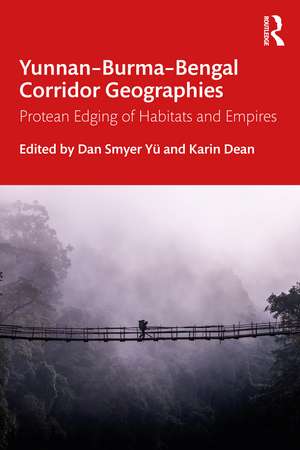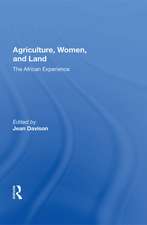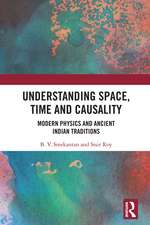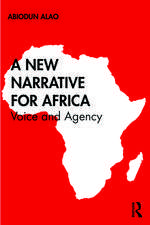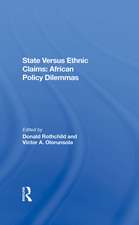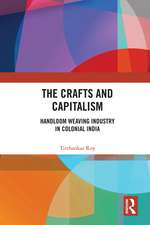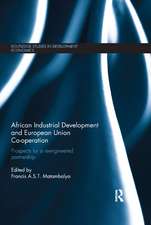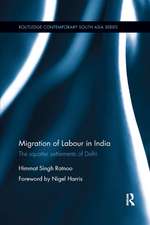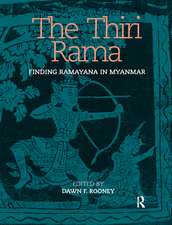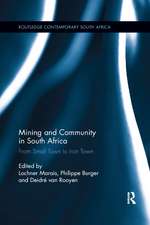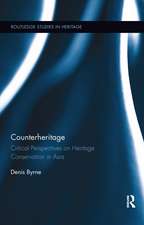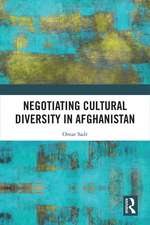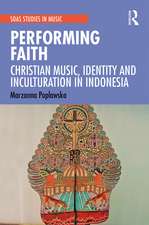Yunnan–Burma–Bengal Corridor Geographies: Protean Edging of Habitats and Empires
Editat de Dan Smyer Yü, Karin Deanen Limba Engleză Paperback – 30 sep 2021
Comprehensive and topical, with its wide-ranging case studies, this book will be of interest to scholars and researchers of history, routes and border studies, sociology and social anthropology, South East Asian history, South Asian history, Chinese studies, environmental history, human geography, international relations, ecology, and cultural studies.
| Toate formatele și edițiile | Preț | Express |
|---|---|---|
| Paperback (1) | 353.79 lei 6-8 săpt. | |
| Taylor & Francis – 30 sep 2021 | 353.79 lei 6-8 săpt. | |
| Hardback (1) | 1002.32 lei 6-8 săpt. | |
| Taylor & Francis – 30 sep 2021 | 1002.32 lei 6-8 săpt. |
Preț: 353.79 lei
Nou
Puncte Express: 531
Preț estimativ în valută:
67.70€ • 70.77$ • 57.21£
67.70€ • 70.77$ • 57.21£
Carte tipărită la comandă
Livrare economică 07-21 martie
Preluare comenzi: 021 569.72.76
Specificații
ISBN-13: 9780367556228
ISBN-10: 0367556227
Pagini: 274
Ilustrații: 4
Dimensiuni: 156 x 234 x 15 mm
Greutate: 0.39 kg
Ediția:1
Editura: Taylor & Francis
Colecția Routledge India
Locul publicării:Oxford, United Kingdom
ISBN-10: 0367556227
Pagini: 274
Ilustrații: 4
Dimensiuni: 156 x 234 x 15 mm
Greutate: 0.39 kg
Ediția:1
Editura: Taylor & Francis
Colecția Routledge India
Locul publicării:Oxford, United Kingdom
Public țintă
PostgraduateCuprins
Perpendicular Geospatiality of Corridors and Borderlands: An Introduction
PART I. CONCEPTUAL THOUGHTS
1. Framing Spaces between India and China
2. Environmental Edging of Empires, Chiefdoms and States: Corridors as Transregions
3. A Conceptualization of Tibetan–Myanmar Corridors
PART II. HUMAN–NONHUMAN CORRIDORS AND COMMONS
4. Understanding Borderlands through Elephant Corridors in the Yunnan–Myanmar–Bengal Landscape
5. Rivers of Mobility: Multi-ethnic Societies and Ecological Commons in a Fluvial Asia
6. Borderlines, Livelihood and Ethnicity in the Yunnan–Myanmar Borderlands: A Rohingya Jade Trader’s Narratives
PART III. IMPERIAL FRONTIERS, ETHNOPOLITICS AND BORDERLAND LIVELIHOODS
7. Ethnonationalism in Northeast India: A Case Study of the Ban on Hindi Movies and Songs in Manipur
8. Constructing Native Chieftains as Imperial Frontier Institution: Endogamy and Dowry Land Exchange among the Shan-Dai Chieftains in Yunnan–Burma Borderland since the Thirteenth Century
9. Beyond Taste: The Flow of De’ang’s Fermented Tea in Yunnan–Myanmar Borderlands
10. Leaving the Mountain: Wage Laborers and Gendered Yearnings in a Northwest Lao Border Town.
Conclusion: Corridor Geographies
PART I. CONCEPTUAL THOUGHTS
1. Framing Spaces between India and China
2. Environmental Edging of Empires, Chiefdoms and States: Corridors as Transregions
3. A Conceptualization of Tibetan–Myanmar Corridors
PART II. HUMAN–NONHUMAN CORRIDORS AND COMMONS
4. Understanding Borderlands through Elephant Corridors in the Yunnan–Myanmar–Bengal Landscape
5. Rivers of Mobility: Multi-ethnic Societies and Ecological Commons in a Fluvial Asia
6. Borderlines, Livelihood and Ethnicity in the Yunnan–Myanmar Borderlands: A Rohingya Jade Trader’s Narratives
PART III. IMPERIAL FRONTIERS, ETHNOPOLITICS AND BORDERLAND LIVELIHOODS
7. Ethnonationalism in Northeast India: A Case Study of the Ban on Hindi Movies and Songs in Manipur
8. Constructing Native Chieftains as Imperial Frontier Institution: Endogamy and Dowry Land Exchange among the Shan-Dai Chieftains in Yunnan–Burma Borderland since the Thirteenth Century
9. Beyond Taste: The Flow of De’ang’s Fermented Tea in Yunnan–Myanmar Borderlands
10. Leaving the Mountain: Wage Laborers and Gendered Yearnings in a Northwest Lao Border Town.
Conclusion: Corridor Geographies
Notă biografică
Dan Smyer Yü is Kuige Professor of Ethnology at the School of Ethnology and Sociology and the National Centre for Borderlands Ethnic Studies in Southwest China at Yunnan University, China and a member of the International Faculty Program at Die Universität zu Köln, Germany. He specializes in religion and ecology, environmental humanities, trans-Himalayan studies, sacred landscapes, and modern Tibetan studies. He currently serves as a member of the Advisory Group of Yale Forum on Religion and Ecology and as an elected board member of the International Society for the Study of Religion, Nature and Culture. He is the author of Mindscaping the Landscape of Tibet: Place, Memorability, Eco-aesthetics (2015), and the co-editor of Environmental Humanities in the New Himalayas: Symbiotic Indigeneity, Commoning, Sustainability (Routledge 2021).
Karin Dean is Senior Researcher at the School of Humanities, Tallinn University, Estonia. Trained as a political geographer at the National University of Singapore, her research interests include boundaries, borderlands, practices of b/ordering, power topologies, and, more recently, the spatial effects of large-scale infrastructure development in Yunnan and northeast India. She has worked in conflict resolution and conducted extensive academic fieldwork at most of Myanmar’s borderlands, and published in multiple journals and books, including Political Geography, Eurasian Geography and Economics, Surveillance and Society, Ashgate Research Companion to Border Studies, and the Routledge Handbook on Asian Borderlands.
Karin Dean is Senior Researcher at the School of Humanities, Tallinn University, Estonia. Trained as a political geographer at the National University of Singapore, her research interests include boundaries, borderlands, practices of b/ordering, power topologies, and, more recently, the spatial effects of large-scale infrastructure development in Yunnan and northeast India. She has worked in conflict resolution and conducted extensive academic fieldwork at most of Myanmar’s borderlands, and published in multiple journals and books, including Political Geography, Eurasian Geography and Economics, Surveillance and Society, Ashgate Research Companion to Border Studies, and the Routledge Handbook on Asian Borderlands.
Recenzii
'The unbroken yet dramatic ecologies and histories of the lands from the Brahmaputra to the Mekong, long disintegrated in academic research, is finding a new field today. Yunnan–Burma–Bengal Corridor Geographies is a valuable contribution which brings trans-Himalayan studies and borderland studies into conversation. It is a must for anyone interested in the long-term transitions, human-nonhuman interconnections, and acute borderland politics of the region.'
Gunnel Cederlöf, Professor of History, Department of Cultural Sciences and Centre for Concurrences in Colonial and Postcolonial Studies, Linnaeus University, Sweden
'This highly original and challenging collection of essays on the "corridor geographies" connecting southwest China, northern southeast Asia, the Bangladesh borderlands, and northeast India, is essential reading for anyone who wishes to consider how human diversity, biodiversity, and ecological history intersect over time and space. The variety of the case studies, each exploring different patterns of transregional connectivity in human and more than human contexts, will pay immense rewards for scholars and students who seek a rich intellectual engagement with the concept of bordered connectivity that "corridor geographies" provides.'
Mandy Sadan, Associate Professor of Global Sustainable Development, University of Warwick, UK
'This book contributes richly to building bridges between conceptions of areas, countries and even broad Asian subregions, that are not normally thought to have much in common. The beauty of its approach is, in my view, to take example on diverse and often neglected upland societies in this particular corridor, who are themselves transnational and do cross borders as a matter of routine. For most, they were already occupying that space before the very advent of the said borders. In this way, and beyond the flawed gaze of the Nation-State, past and present meet again.'
Jean Michaud, Professor of Anthropology, Université Laval, Canada
Gunnel Cederlöf, Professor of History, Department of Cultural Sciences and Centre for Concurrences in Colonial and Postcolonial Studies, Linnaeus University, Sweden
'This highly original and challenging collection of essays on the "corridor geographies" connecting southwest China, northern southeast Asia, the Bangladesh borderlands, and northeast India, is essential reading for anyone who wishes to consider how human diversity, biodiversity, and ecological history intersect over time and space. The variety of the case studies, each exploring different patterns of transregional connectivity in human and more than human contexts, will pay immense rewards for scholars and students who seek a rich intellectual engagement with the concept of bordered connectivity that "corridor geographies" provides.'
Mandy Sadan, Associate Professor of Global Sustainable Development, University of Warwick, UK
'This book contributes richly to building bridges between conceptions of areas, countries and even broad Asian subregions, that are not normally thought to have much in common. The beauty of its approach is, in my view, to take example on diverse and often neglected upland societies in this particular corridor, who are themselves transnational and do cross borders as a matter of routine. For most, they were already occupying that space before the very advent of the said borders. In this way, and beyond the flawed gaze of the Nation-State, past and present meet again.'
Jean Michaud, Professor of Anthropology, Université Laval, Canada
Descriere
This volume explores the historical interconnections between Bengal, Burma and Yunnan (China) with a focus on corridor geographies. It presents the complexity of premodern and modern pathways, shared environmental and human history, networks of livelihood-making, commerce, religions, political systems, and colonial encounters.
